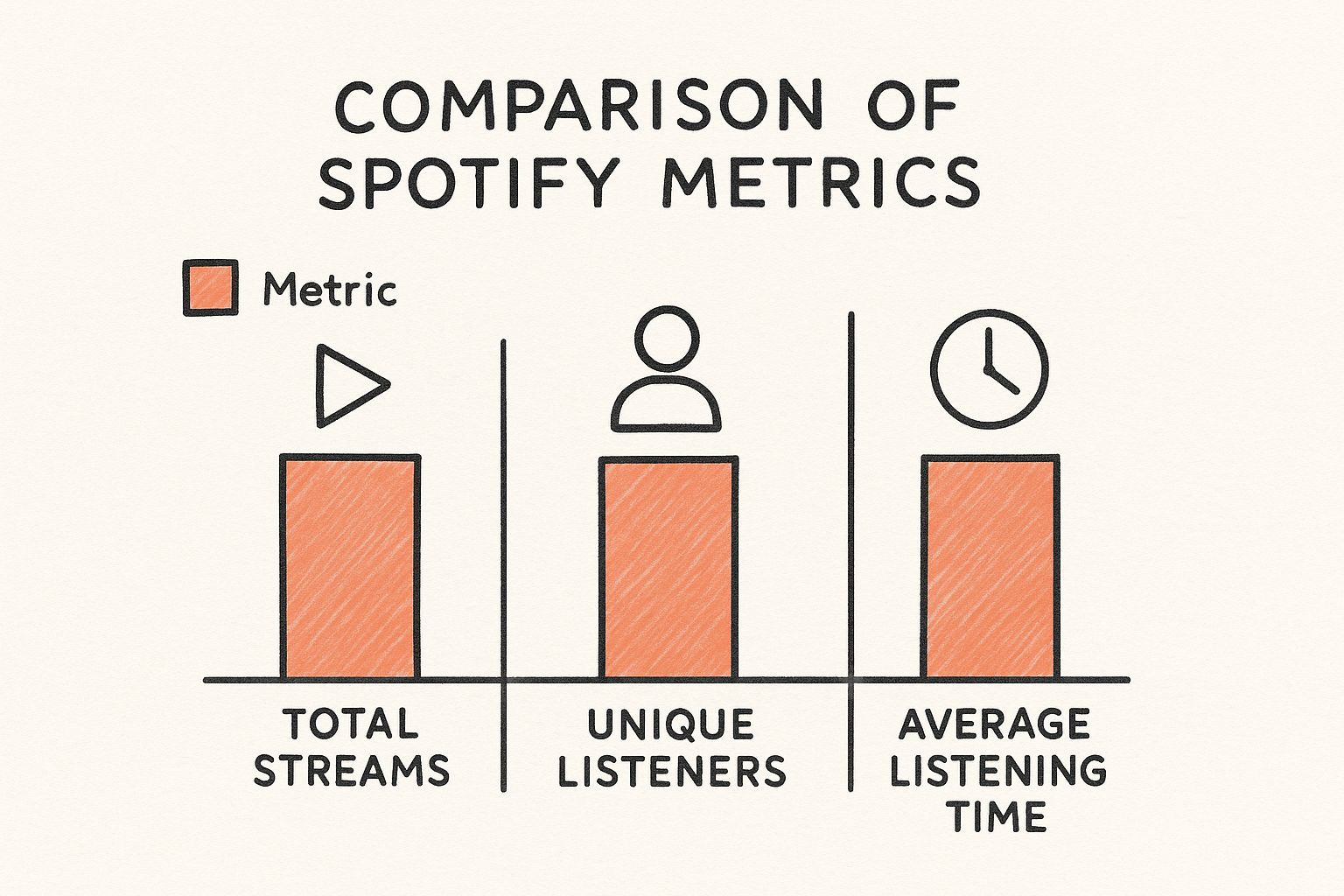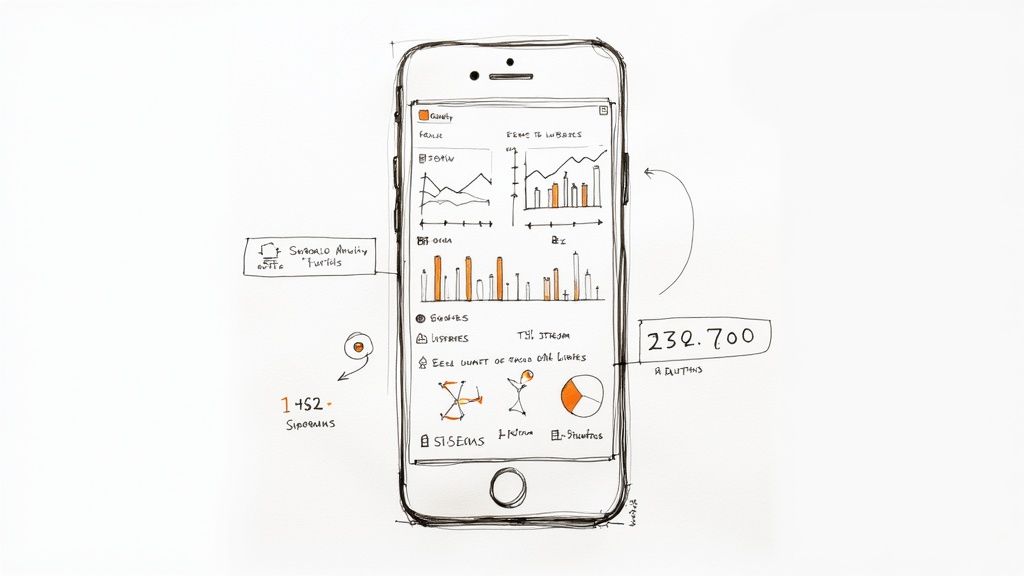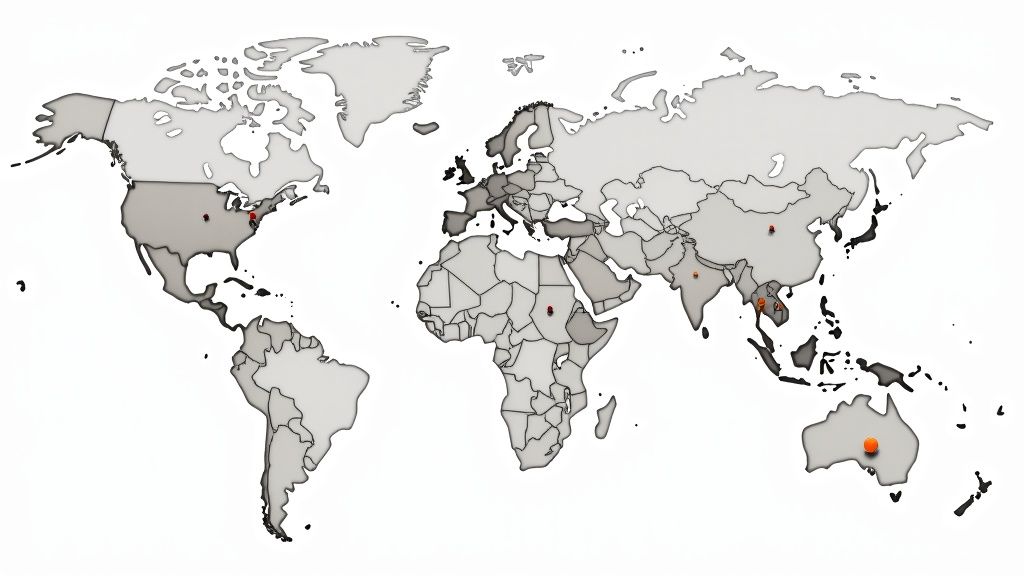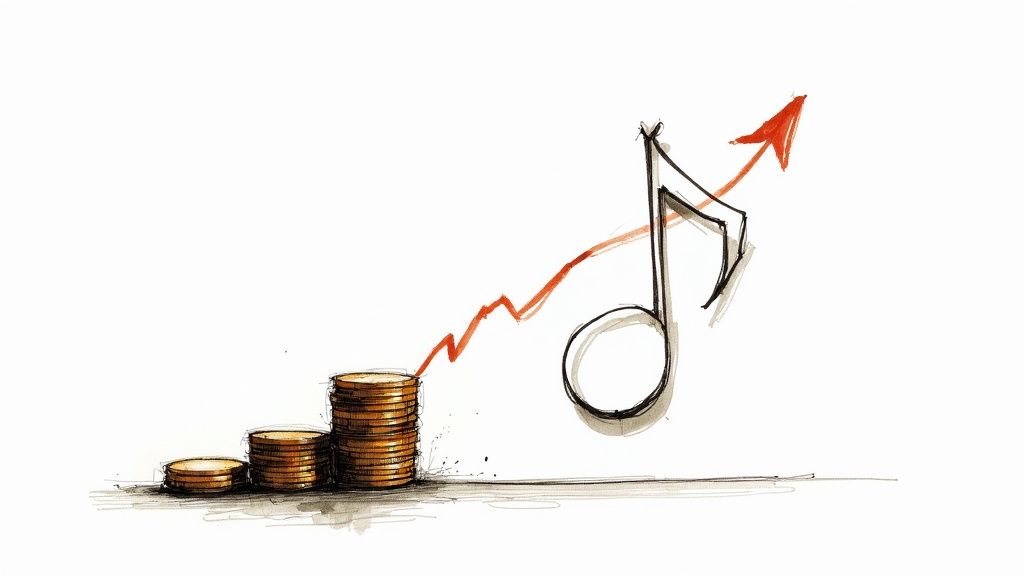Spotify Analytics for Artists: Boost Your Music Insights
- Aaron Whittington

- May 27
- 13 min read
Mastering Your Spotify For Artists Dashboard Like A Pro
Your Spotify for Artists dashboard is a goldmine of information, providing key insights into your listeners and how your music is performing. Understanding these Spotify analytics for artists is essential for growth. This section breaks down the essential elements of your dashboard and how to use this data for a successful music career.
Understanding Key Metrics
Three fundamental metrics form the core of your dashboard: total streams, unique listeners, and average listening time. These numbers offer a snapshot of your overall performance and audience engagement. The infographic below provides a clear comparison:

This visualization highlights how these metrics relate to each other. Total streams show overall popularity, unique listeners indicate your reach, and average listening time demonstrates how much your music resonates with your audience. These insights form the basis for strategic decision-making, helping you focus on areas for improvement. For more insights on using Spotify analytics, check out this resource: How to Spot Streaming Trends Using Spotify Analytics.
Diving Deeper With Your Dashboard
The Spotify for Artists dashboard offers a wealth of information beyond these core metrics. The "Audience" tab, for example, provides valuable demographic data, showing the age, gender, and location of your listeners. This is crucial for targeted marketing and tailoring your content to resonate with key demographics.
The "Songs" tab provides a track-by-track performance breakdown, revealing which songs are generating the most engagement and which might need more attention. This allows you to optimize your release strategy and promotional efforts.
Speaking of top performers, Taylor Swift currently holds the title of most-streamed artist globally on Spotify, with an astounding 28.21 billion streams in the past year. This impressive figure highlights the platform's potential reach and impact. Other artists like The Weeknd, Drake, Bad Bunny, and Billie Eilish also demonstrate this global dominance with billions of streams each. This underscores the importance of using Spotify for Artists to track performance and gain valuable audience insights. You can find more detailed statistics here: Spotify Statistics.
To help you navigate the wealth of data available, here’s a handy table summarizing some essential metrics:
Understanding these data points is just the first step. True mastery comes from turning these insights into actionable strategies.
Essential Spotify Analytics Metrics Comparison A breakdown of key metrics available in Spotify for Artists and their importance for different career stages
Metric | What It Measures | Best For | Frequency to Check |
|---|---|---|---|
Total Streams | Overall plays of your music | All career stages | Weekly |
Unique Listeners | Number of individual people listening | Growth and reach | Weekly/Monthly |
Average Listening Time | How long people listen to your tracks | Engagement and content strategy | Monthly |
Listener Demographics (Age, Gender, Location) | Audience breakdown | Targeted marketing and content creation | Monthly/Quarterly |
Song-Specific Performance | Plays, saves, shares, playlist adds per track | Refining release strategy and promotion | Weekly |
This table highlights the key metrics you should be tracking on your Spotify for Artists dashboard and how often you should be reviewing them. By understanding these metrics, you can gain valuable insights into your audience and how they interact with your music.
Maximizing Your Data for Growth
By analyzing listener demographics, you can identify your core fanbase and tailor content to their preferences. This detailed understanding of your audience helps you create more engaging music and develop promotional campaigns that truly connect.
By closely monitoring song performance data, you can pinpoint which elements of your music are driving engagement and build on those successes. This data-driven approach helps refine your artistic direction and create music that resonates more deeply with your listeners.
Decoding Your Audience Data For Strategic Growth

Moving beyond basic metrics, your audience insights reveal a more nuanced story than simple demographics. This deeper level of understanding allows you to pinpoint your core fanbase – your superfans – and differentiate them from casual listeners. This distinction can have a significant impact on your career trajectory. This section explores how successful artists use this data for strategic growth.
Identifying Your Superfans
Think of your audience data as valuable market research. Just as businesses identify their ideal customer, you need to understand who is truly connecting with your music. Spotify for Artists offers the tools to pinpoint these dedicated listeners.
For example, examine metrics like average listening time and repeat listening rates. High numbers in these areas indicate a strong, dedicated fanbase. This engaged group is more likely to purchase merchandise, attend your concerts, and promote your music organically.
Additionally, the "Songs" tab provides key information about individual track performance. Focus on which songs have high save rates and are frequently added to playlists. These details offer insights into what truly resonates with your superfans and can inform your future creative decisions. This knowledge helps you tailor your content to keep them engaged and coming back for more.
Using Data to Drive Strategy
Successful artists leverage age and geographic data to make informed decisions. For example, understanding where your listeners are concentrated geographically can help you plan more effective tours. Imagine an artist uncovering a surprisingly high concentration of fans in a previously untapped region.
This data could lead to adding a new tour stop, potentially creating a new revenue stream and broadening their fanbase. This strategic use of data is crucial for maximizing impact and fostering deeper connections with fans.
Beyond touring, understanding your audience’s age range helps refine your marketing messages and select appropriate promotional channels. A younger audience might respond well to campaigns on TikTok, while an older demographic might be better reached through email newsletters or targeted Facebook ads. This tailored approach ensures your marketing efforts are efficient and connect with the right audience. These insights transform data points into powerful strategic tools.
Case Studies and Career Pivots
Real-world examples illustrate how analyzing audience patterns can spark significant career changes. One artist, after reviewing their Spotify for Artists data, discovered a substantial portion of their listeners were located in a country they hadn't previously focused on.
This realization prompted a targeted marketing campaign in that region, leading to a significant increase in streams and new fan acquisition. These scenarios demonstrate the tangible impact of data-driven decision-making.
Furthermore, analyzing listening trends over time can reveal shifts in audience preferences. Perhaps a certain genre or style of music is gaining traction within your fanbase. This awareness can inform your artistic direction and encourage experimentation with new sounds. This constant evolution is essential for staying relevant and maintaining audience engagement.
Actionable Frameworks for Growth
Developing practical frameworks for using data is paramount. This could involve creating a spreadsheet to track key metrics like playlist adds, save percentages, and listener demographics. Consistently monitoring this data enables artists to spot trends and make informed decisions about their promotional activities.
These frameworks provide a structured approach to navigating the wealth of information available in Spotify for Artists. Through consistent analysis and strategic application of data, artists can build a foundation for lasting success in the music industry.
Turning Song Performance Data Into Hit-Making Insights

The music industry is constantly evolving, and the difference between a viral hit and lasting success often lies in understanding your data. Spotify analytics for artists provides more than just vanity metrics; it offers a deep dive into listener behavior. This section explores how successful artists use this data to replicate their wins.
Analyzing Key Performance Indicators
For artists, effectively using Spotify analytics means examining completion rates, save percentages, and playlist performance. These key performance indicators (KPIs) reveal how listeners interact with your music. A high completion rate, for example, suggests listeners are engaged from start to finish.
Conversely, a low completion rate may indicate issues with song structure, pacing, or overall engagement. This metric can pinpoint areas for improvement in songwriting or production. A high save percentage signals listeners adding your songs to their libraries, indicating a deeper connection. These data points begin to reveal true audience engagement. You might find this resource helpful: Boost Your Music Careers With Spotify Stream Data Insights.
Unpacking Playlist Performance
Playlist placements are vital for discovery on Spotify. Tracking which playlists feature your music and how your songs perform within them is crucial. Monitor the number of streams, saves, and new playlist followers gained from each placement.
This allows you to evaluate your playlist pitching strategy and identify the most beneficial playlists. Analyzing playlist performance also reveals how algorithmic discovery differs from organic discovery. Algorithmic playlists are often data-driven and personalized, while organic placements rely on curator selections. Understanding these differences helps refine promotional strategies and target the right playlists.
From Data to Actionable Insights
Analyzing song performance data means understanding why certain songs resonate. This requires going beyond simply identifying top performers and uncovering the elements that create genuine connection.
For instance, a high save rate coupled with a low completion rate might suggest listeners are initially drawn in but lose interest. This could be due to various factors, like a weak bridge or repetitive chorus. Identifying these patterns helps artists make informed decisions about future releases.
Spotting Breakthrough Potential and Investment Strategies
Industry professionals utilize advanced analytics to identify early indicators of a song's breakthrough potential. This includes examining factors like early stream velocity, listener demographics, and initial playlist adds. These insights help predict which songs warrant further investment and support.
By analyzing these metrics, artists can prioritize resources and amplify the reach of songs showing strong resonance. This data-driven approach maximizes promotional impact and increases the chances of turning promising tracks into true hits.
Geographic Insights That Drive Real Opportunities
Your streaming geography holds the key to unlocking untapped revenue. While many artists might overlook the importance of location data, it can be a powerful tool for career growth. This section explores how successful artists use geographic insights to discover new markets, plan effective tours, and optimize release timing.
Identifying Emerging Markets Before Your Competitors
Savvy artists use geographic data from Spotify for Artists to identify emerging markets. This allows them to connect with new audiences before their competitors even realize the potential. Imagine discovering a sudden increase in listeners in a specific city or country. This valuable insight provides a head start in establishing a strong presence in a burgeoning market.
Planning Strategic Tour Routes
Geographic data is essential for optimizing tour routes. By understanding where your listeners are concentrated, you can plan tours that maximize both attendance and profitability. This data-driven approach allows you to focus on areas with a high density of fans, ensuring sold-out shows and enthusiastic crowds.
For example, instead of relying on overall popularity metrics, an artist might discover a significant cluster of fans in a smaller, less obvious city. This information could lead to adding a new tour stop, expanding their reach and personally connecting with fans in a new market. This strategic use of data optimizes touring costs and boosts potential revenue.
Timing Releases for Global Impact
Geographic data is also a valuable tool for planning release times. Understanding the time zones of your key markets helps you coordinate releases for maximum global impact. This strategic approach ensures your music reaches the widest possible audience at the most opportune time.
Consider an artist with a substantial fanbase in both Europe and North America. By carefully selecting a release time, they can capture peak listening hours in both regions, maximizing exposure. This coordinated strategy can significantly boost initial stream counts and overall reach.
Building Authentic Connections With International Audiences
Connecting with international fans is paramount for career growth. Use Spotify for Artists data to pinpoint high-performing regions and develop targeted campaigns. By understanding the cultural nuances of these markets, you can tailor your messaging to resonate authentically with diverse audiences.
Partnering with local influencers and playlist curators is another effective strategy. These collaborations amplify your reach within specific markets and foster genuine connections with international fans. Working with influencers provides access to their established audience, helping to build trust and loyalty.
Spotting Growth Trends and Building Targeted Campaigns
Analyzing Spotify analytics for artists allows you to identify growth trends in new regions. Perhaps a specific country suddenly displays increased engagement with your music. This trend could signal an emerging market ripe for a targeted campaign. Develop customized promotional strategies for these regions, including social media outreach, local partnerships, and tailored content.
For instance, an artist experiencing rapid growth in Brazil might partner with Brazilian influencers and playlist curators. This could be combined with social media advertising specifically targeted at Brazilian listeners. This integrated approach creates powerful synergy between data insights and promotional efforts.
This geographically-focused approach to using Spotify for Artists empowers you to maximize your reach and build strong relationships with fans worldwide. By transforming data into actionable insights, you can unlock significant growth opportunities and build a lasting global presence in the music industry.
Data-Driven Release Strategies That Actually Work

Turning Spotify analytics into actionable release strategies is vital for maximizing a song's impact. This means analyzing past campaigns to identify performance patterns and predict the best possible release timing. It’s about going beyond simple stream counts and understanding the bigger picture your data presents.
Using Historical Data to Predict Optimal Timing
Successful artists treat historical performance data like a roadmap. They analyze when their previous releases performed best, examining factors like the day of the week and even the time of day. This allows them to recognize recurring patterns and pinpoint the optimal release window for their specific audience.
For example, if an artist’s past releases consistently perform better on Fridays, it suggests their audience is most active then. This insight informs their future release schedule, improving their chances of reaching a wider audience right out of the gate. This data-driven approach takes the guesswork out of release planning.
Leveraging Audience Engagement Data for Promotion
Knowing how your audience engages with your music is essential for choosing the right promotional tactics. Spotify for Artists provides valuable data on listener demographics, listening habits, and preferred content types. This information helps tailor promotional activities to truly connect with your target audience.
If your data shows a high concentration of younger listeners engaging with short-form video content, platforms like TikTok might be a primary focus for promotion. However, if your audience skews older and prefers long-form content, concentrating on platforms like YouTube or in-depth interviews could be more effective. This personalized approach maximizes the impact of your promotional budget. You might be interested in: Unlock Insights With Spotify Playlist Data Strategies.
Determining Release Schedules Based on Listening Habits
Analyzing listening habits reveals when your audience is most active on Spotify. This data is invaluable for creating release schedules that capture maximum attention. Some audiences might be most active during their commutes, while others prefer evening listening sessions.
Matching your release time to these peak listening periods can greatly affect your initial stream counts and overall reach. This strategic approach ensures your music reaches your audience when they’re most likely to listen.
A/B Testing and Measuring Campaign Effectiveness
Many music industry professionals utilize A/B testing to compare different release strategies. This involves testing two different approaches simultaneously, such as releasing a song on a Friday versus a Wednesday. Measuring key metrics like first-day streams, playlist adds, and save percentages reveals which strategy performs best.
This provides concrete evidence of what resonates with your audience, allowing for adjustments based on actual results. This iterative process of testing and refining is key to continuous improvement.
The following table, "Release Strategy Performance Metrics," outlines key indicators to track when optimizing your music release timing and promotional approach. By monitoring these factors, artists can make informed decisions to improve their results.
Release Strategy Performance Metrics
Release Factor | Metric to Track | Optimal Range | Action if Below Target |
|---|---|---|---|
Release Day | First-day Streams | Varies based on artist size | Adjust release day for future releases |
Release Time | Streams within the first 24 hours | Varies based on target audience location | Optimize release time to align with audience activity |
Pre-save Campaign | Number of pre-saves | Set realistic goals based on previous campaigns | Re-evaluate pre-save campaign strategy |
Playlist Placements | Streams and saves from playlists | Track individual playlist performance | Refine playlist pitching strategy |
This table demonstrates the value of tracking metrics beyond simple stream counts. By also considering factors like pre-save campaigns and playlist placements, artists develop a more complete understanding of their release strategy's effectiveness.
Considering Artist Size and Budget
Effective release strategies are adaptable to different artist sizes and budgets. While major label artists may have extensive marketing resources, independent artists can achieve significant results with focused, data-driven approaches.
This might involve utilizing free tools like social media and email marketing to build a direct connection with fans. The key is using available resources strategically, prioritizing the tactics most likely to deliver results based on your audience and budget. This adaptable mindset is essential for success at every level of the music industry.
Advanced Analytics Strategies For Serious Artists
Building a sustainable music career takes more than just raw talent and killer tracks. It requires a deep understanding of your audience and how they connect with your music. This means moving beyond simple metrics and embracing advanced analytics to inform your decisions. That's where Spotify analytics for artists becomes a powerful tool.
Cohort Analysis: Understanding Listener Lifecycle Patterns
Cohort analysis groups listeners based on when they first discovered your music. By tracking their engagement over time, you can see how their behavior changes as they get more familiar with your work. This reveals valuable insights into the listener lifecycle.
For example, listeners who found you through a specific playlist might initially stream the featured song heavily, but engage less with your other tracks. Following this cohort over weeks and months reveals whether they branched out and became dedicated fans.
Predictive Modeling: Anticipating Future Release Performance
Analyzing past release performance helps develop predictive models for future releases. Factors like release day, time of day, and even the season can reveal what resonates with your audience. These patterns can optimize the timing and promotion of new music.
Imagine an artist consistently sees higher engagement during summer. This trend could inform their release schedule, prioritizing summer releases for maximum impact. This data-driven approach lets artists anticipate fan reactions and make smart decisions.
Algorithmic Performance Trends: Spotting Breakthrough Potential
Tracking your performance on algorithmic playlists like Discover Weekly is crucial for understanding how Spotify’s algorithms see your music. Increased streams from algorithmic playlists can be an early sign of breakthrough potential. Closely monitoring your Spotify for Artists dashboard is key here.
Watch which playlists feature your music and how your songs rank. A sudden surge in placements or a rapid climb in playlist rankings suggests the algorithm is recognizing your music’s growing popularity. This is a valuable signal to capitalize on, perhaps by increasing promotion around those tracks.
Advanced Segmentation: Understanding Your Fan Personas
Advanced segmentation goes further than basic demographics, grouping listeners based on shared behaviors. This could involve segmenting by listening frequency, preferred genres, or even listening times. This allows you to build detailed fan personas and tailor campaigns to each segment.
For example, you might find a segment of fans who consistently stream your music late at night. This could influence your social media strategy, scheduling posts and engaging with them during those peak hours. This personalized approach strengthens fan connections and builds loyalty.
Competitive Benchmarking: Gaining Actionable Insights
Competitive benchmarking isn’t just comparing stream counts. It’s analyzing the strategies of similar artists to see what's working for them. Look at their release frequency, promotional activities, and playlist placements to identify actionable insights.
Perhaps a competitor’s use of short-form video is driving engagement. This could inform your own promotion, leading you to experiment with similar content. This provides real-world inspiration for your own efforts.
Long-Term Career Planning: Beyond Gut Feelings
Data-driven decisions are crucial for long-term career planning. Tracking metrics over time reveals long-term trends in listener behavior, allowing you to adapt your strategy accordingly. This replaces guesswork with informed choices.
Perhaps your data reveals a gradual decline in listener engagement. This insight could encourage you to refresh your content, experiment with new sounds, or try different promotional approaches. This proactive approach is vital for maintaining momentum and achieving lasting success.
Ready to transform your music career with data-driven insights? Visit artist.tools today to discover a comprehensive suite of tools designed to empower musicians on Spotify.
Each segment in the Geometry Dash Scratch levels will immerse you in completely new and challenging scenes and designs.